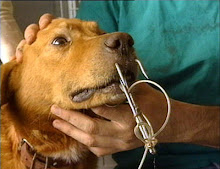Did you know that your dog can be poisoned from just being in the house that causes cancer and hyperthyroidism?
Their were test where they found that some of the animals were contaminated with 48 of 70 industrial chemicals tested, including 43 chemicals at levels higher than those typically found in people, according to our study of plastics and food packaging chemicals, heavy metals, fire retardants, and stain-proofing chemicals in pooled samples of blood and urine from 20 dogs and 37 cats collected at a Virginia veterinary clinic.
Here is just part 1 of the report
Amounts of Toxics in Blood and Urine Many Times Higher in Pets Than Humans
WASHINGTON – In the first study of its kind, Environmental Working Group (EWG) found that companion cats and dogs are polluted with even higher levels of many of the same synthetic industrial chemicals that researchers have recently found in people, including newborns.
In addition to being guardians, playmates and even beloved family members, dogs and cats may also be serving as sentinels for human health problems that can arise from exposures to industrial chemicals.
In recognition of the unique roles that pets play in our lives, the Environmental Working Group (EWG) undertook a study to investigate the extent of exposures dogs and cats face to contaminants in our homes and outdoor environments. What we found was startling.
Dogs and cats were contaminated with 48 of 70 industrial chemicals tested, including 43 chemicals at levels higher than those typically found in people, according to our study of blood and urine from 20 dogs and 40 cats. Average levels of many chemicals were substantially higher in pets than is typical for people, with 2.4 times higher levels of stain-and grease-proof coatings (perfluorochemicals) in dogs, 23 times more fire retardants (PBDEs) in cats, and more than 5 times the amounts of mercury, compared to average levels in people found in national studies conducted by the Centers for Disease Control and Prevention (CDC) and EWG.
“Like humans, pets are also exposed to toxic chemicals on a daily basis, and as this investigation found, are contaminated at higher levels,” said Jane Houlihan, VP for Research at EWG. “The presence of chemicals in dogs and cats sounds a cautionary warning for the present and future health of children as well. This study demonstrating the chemical body burden of dogs and cats is a wake-up call for stronger safety standards from industrial chemical exposures that will protect all members of our families, including our pets.”
“This study is valuable in that it used pet animals that live in nearly fifty percent of all US households as environmental sentinels to measure the level of contamination with a wide variety of industrial chemicals that have also been shown to be present in human tissue. Because pet animals tend to have similar or higher concentrations of these chemicals in their body than humans, epidemiological studies of pets can be used to identify potential adverse health effects at a lower cost and in a much shorter period of time than it would take to perform similar studies in humans,” said Dr. Larry Glickman – a leading veterinarian and distinguished scientist who for the past three decades conducted research in veterinary epidemiology.
"This study shows that our pets are susceptible to the absorption of potentially harmful chemicals from our environment just as we are. Perhaps even more troubling is that these chemicals have been found in higher levels in pets than in humans implying potential harmful consequences for their health and well being and the need for further study," said Dr. John Billeter, DVM, the veterinarian who conducted the blood and urine tests.
Just as children ingest pollutants in tap water, play on lawns with pesticide residues, or breathe in an array of indoor air contaminants, so do their pets. But with there compressed lifespans, developing and aging seven or more times faster than children, pets also develop health problems much more rapidly. Pets, like infants and toddlers, have limited diets and play close to the floor, often licking the ground as well as their paws, greatly increasing both their exposures to chemicals and the resulting health risks.
In America there are 8 times more companion dogs and cats than there are children under five. Seventy percent more households have dogs or cats than children of any age. These pets are often beloved family members, and yet they can be subjected to chronic, constant exposures to chemical contaminants in homes, yards, and parks that pet owners cannot always prevent.
Scientists Link Chemical Exposure to Increased Rates of Cancer, Other Diseases in Pets:
Under current federal law, chemical companies do not have to prove chemicals are safe before they are used in products, including pet toys and other products for our companion animals. For pets as for people, the result is a body burden of complex mixtures of industrial chemicals never tested for safety. Health problems in pets span high rates of cancer in dogs and skyrocketing incidence of hyperthyroidism in cats. Genetic changes can't explain the increases in certain health problems among pets, leaving scientists to believe that chemical exposures play a significant role.
EWG is a nonprofit research organization based in Washington, DC that uses the power of information to protect human health and the environment.
Read the full report by EWG here.
Saturday, April 19, 2008
Subscribe to:
Post Comments (Atom)

















No comments:
Post a Comment